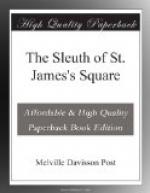“Look, monsieur,” she said. “It is his left hand he is holding up!”
Immediately Thompson raised the other hand. “I beg your pardon, Your Honor,” he muttered. “I am left-handed; I sometimes make that mistake.”
And again the girl cried out: “You see . . . you notice it . . . it is true, then . . . he is left-handed.”
“I see he is left-handed,” said the judge, “but what has that to do with the case?”
“Oh, monsieur,” she said, “it has everything to do with it. I will show you.”
She moved up on the step before the judge’s bench and laid the menu before him. The attorney for the prosecution also arose. He wished to prevent this proceeding, to object to it, but he feared to disturb the judge and he remained silent.
“Monsieur,” she said, “I have made a little drawing . . . I know how such things are done . . . . My father was juge d’instruction of the Canton of Vaud. He always made little drawings of places where crimes were committed. . . . Here you will see,” and she put her finger on the card, “the narrow passage leading from the butler’s pantry into the dining-room used for a library. You will notice, monsieur, that the writing-table stood with one end against the wall, the left wall of the room, as one enters from the butler’s pantry. It is a queer table. One side of it has a row of drawers coming to the floor and the other side is open so one may sit with one’s knees under it. On the night of the tragedy this table was sitting at right angles to the left wall, that is to say, monsieur, with this end open for the writer’s knees close up against the left wall of the room. That meant, monsieur, that on this night Mr. Marsh was sitting at the table with his back to the passage from the butler’s pantry, close up against the left wall of the room.
“Therefore, monsieur,” the girl went on, “the man who assassinated Mr. Marsh entered from the butler’s pantry. He slipped into the room along the left wall close up behind his victim . . . . Did it not occur so.”
This was the evidence of the police officials and the experts. It was clear from the position of the desk in the room and from the details of the evidence.
“And, monsieur,” she said, “will you tell me, is it true that the stab wound which killed Mr. Marsh was in the shoulder on the side next to the wall?”
“Yes,” said the judge, “that is true.”
The prosecutor, urged by Thompson, now made a verbal objection. The case was practically completed. The incident going on in the court-room followed no definite legal procedure and could not be permitted to proceed. The judge stopped him.
“Sit down,” he said. He did not offer any explanation or comment. He merely silenced the man and returned to the girl standing eagerly on the step before the bench.
“The wound was in the base of the man’s neck at the top of the left shoulder on the side next to the wall,” he said. “But what has this fact to do with the case?”




